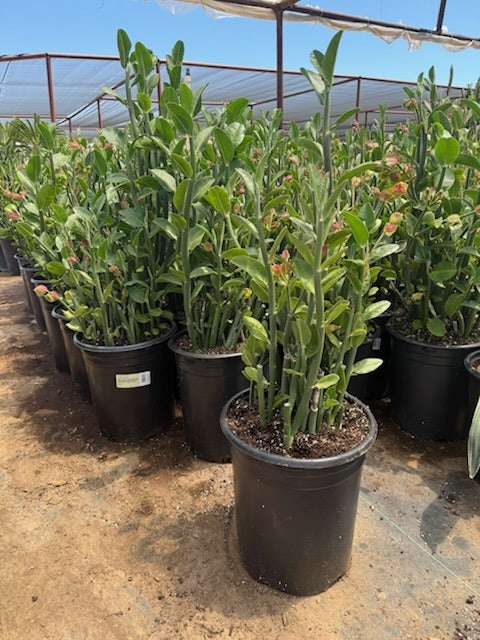My Store
Lady Slipper
Lady Slipper
Couldn't load pickup availability
Plant Type: perennial, shrubby succulent (milkweed family)**
Plant Height: 2–4 feet (can reach 5 feet in maturity)**
Spread: 3–5 feet
Flower Color: orange-red (slipper-shaped)
Sun Exposure: Full sun to light shade
Lady Slipper / Pedilanthus macrocarpus: A Sculptural Desert Succulent with Graceful Curves and Fiery Blooms
Pedilanthus macrocarpus, commonly known as the Lady Slipper Plant, Slipper Spurge, or Candelilla, is a refined, architectural succulent native to the Sonoran and Baja deserts. Belonging to the euphorbia family, it’s celebrated for its smooth, green, pencil-like stems and distinctive orange-red slipper-shaped flowers that bloom throughout the warm months.
In Arizona landscapes, Lady Slipper is a low-water, high-impact plant, combining elegant vertical lines with unique blooms that attract hummingbirds. Its clean form and subtle color variations make it a favorite among designers for modern, xeric, and Mediterranean-style gardens.
Key Features of Pedilanthus macrocarpus
The Lady Slipper plant forms dense clumps of upright, cylindrical stems that are smooth, succulent, and blue-green to gray-green in color. The stems gently curve and branch, giving the plant a graceful, flowing silhouette.
During spring through fall, the plant produces small orange-red “slipper-shaped” flowers at the tips of the stems. These unusual blooms resemble tiny, delicate shoes—hence the name “Lady Slipper.” The flowers are nectar-rich and highly attractive to hummingbirds and pollinators.
Unlike leafy plants, Pedilanthus macrocarpus relies on its stems for photosynthesis, making it incredibly drought-tolerant. It maintains its structure year-round and develops subtle silver tones in cooler months, adding seasonal contrast and interest.
Growing and Care Tips
Pedilanthus macrocarpus thrives in full sun to light partial shade and well-draining, sandy or rocky soil. In the Phoenix Valley, it prefers full morning and midday sun, but may appreciate light afternoon shade during extreme summer heat, especially in reflected light zones.
Water deeply but infrequently during its first growing season—typically every 14–21 days depending on temperature and soil drainage. Once established, it requires very little irrigation, thriving with only occasional watering (every 4–6 weeks in summer). Overwatering can cause stem yellowing or root rot.
It is cold hardy to about 25°F, and will regrow from the base if lightly frosted. Pruning is minimal; simply remove aged or damaged stems in early spring. Handle carefully, as the milky sap can irritate skin—wear gloves when trimming.
For container use, select a wide, shallow pot with a gritty cactus mix or decomposed granite blend to ensure proper drainage.
Landscaping Uses
Lady Slipper is prized for its clean, sculptural lines and low-maintenance elegance, making it ideal for modern, desert, or waterwise landscapes. It works beautifully as a border plant, courtyard accent, or mass planting.
Pair it with Blue Glow Agave, Golden Barrel Cactus, or Firesticks Euphorbia for contrast in texture and color. Its vertical rhythm softens hard edges around pathways, patios, or contemporary architecture, while its blooms bring subtle vibrancy to minimalist designs.
When planted in groups, the slender, upright stems create a soft, architectural rhythm that complements both modern steel-and-stone settings and natural desert rock gardens.
Summary
The Lady Slipper Plant (Pedilanthus macrocarpus) is the epitome of desert elegance—graceful, sculptural, and virtually indestructible. Its smooth vertical stems, fiery orange blooms, and year-round structure make it an ideal plant for Arizona landscapes seeking sophistication with minimal care. Perfect for designers and homeowners alike, Lady Slipper transforms waterwise gardens into living art.
Three Timbers Installation Guide (Feel Free to Follow):
Pedilanthus macrocarpus Planting Guide:
Location: Full sun to light shade; ideal in full morning and midday sun with optional afternoon shade during peak heat. Handles reflected heat and rocky terrain well.
Soil: Use sharply draining soil—blend cactus mix with decomposed granite or pumice. Avoid clay-heavy or compact soils.
Spacing: Allow 3–5 feet between plants for mature spread and airflow.
Planting Depth: Keep the base of stems level with the soil surface. Avoid burying the lower stalks to prevent rot.
Support: None required; the plant is self-supporting and naturally upright.
Watering Guide:
Watering After Planting: Water deeply once after installation to settle the soil. Then allow it to dry fully before watering again. During the first 3–4 months, water every 14–21 days depending on temperature and drainage.
When is the Plant Established? Lady Slipper is considered established after 6–9 months, once new stems emerge and existing ones stand firm and plump.
Watering Once Established: Water every 4–6 weeks in summer if no rainfall occurs. In winter, watering is rarely necessary except during extended drought.
Drip Irrigation Setup: Install one low-flow emitter (0.5–1 gallon per hour) about 8–12 inches from the base. Run sparingly and allow full drying between cycles.
General Watering Tips: Always confirm soil dryness before watering. Overwatering can cause root or stem rot. A top dressing of decomposed granite or gravel improves drainage, prevents splash, and provides a clean, modern finish. Keep top dressing several inches from the stem base for airflow and long-term plant health.
Share
















